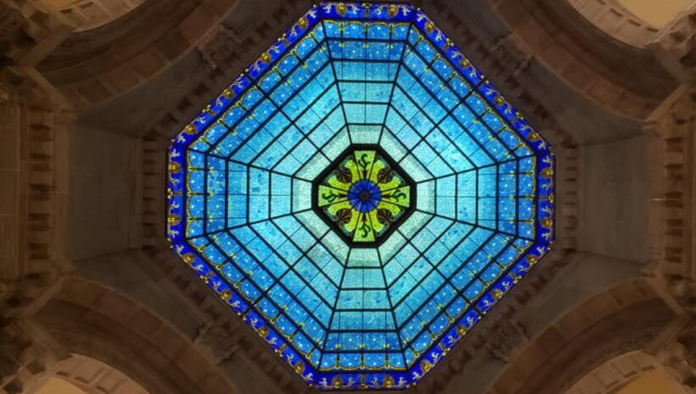By Whitney Downard
Indiana Capital Chronicle
INDIANAPOLIS — A structural engineering study completed in January 2023 quietly closed the iconic dome of the Indiana Statehouse to tours last year due to safety concerns, according to the Indiana Department of Administration (IDOA).
The dome, which has its own lapel pin, is one of the most celebrated parts of the Statehouse and includes 256 panels of colored glass, as detailed by the agency online. But the agency didn’t indicate any plans to reopen the 19th-century structure in the coming years.
The emblematic feature atop the Statehouse includes several architectural elements, including a cupola, which is the smaller structure on top of the dome. The visually striking stained glass dome sits under this outer feature and a skylight, and is just above the central rotunda.
“In 2022, IDOA conducted a structural engineering study to review the steel infrastructure of the State House dome to include all steel staircases, supports, brackets and other supports,” said governor’s office spokeswoman Erin Murphy on behalf of IDOA. “As a result of the study, IDOA determined there needed to be limited access to the dome for safety concerns and therefore ended group tours.”
Access to the dome
Prior to the study — the first structural assessment of the dome that the agency is aware of — IDOA gave small, scheduled tours to Statehouse staff, legislators, interns and more.
“We do not foresee the dome being reopened for tours in the near future. The structure was not designed for multiple people accessing the space at one time,” Murphy continued. “The intent was for maintenance access only. Also, building codes today were not in place when the State House was constructed so there are several code issues related to safety that are a concern.”
IDOA said its facilities management staff, HVAC contractors and fire alarm contractors have access to the dome, which is barred by card readers to limit individual access.
Inside the dome, visitors would use markers to sign their names on the outer walls and, on the other side of the beautiful stained glass, some would spell their names out in dust with their fingers.
Not just a dome
The Statehouse on Capitol Street in Indianapolis is actually the state’s third, following the first Statehouse in Corydon and an earlier building at its current location — the latter of which was demolished to make way for the current edifice that opened in 1888. It cost $2 million to construct at the time.
The Statehouse count doesn’t include Indiana’s territorial seat of government in Vincennes, where the original capitol building still stands. After Indiana became a state in 1816, Corydon became the state seat of government. The first 40-square-foot Statehouse, built from Indiana limestone, also still stands.
The state capital moved to Indianapolis in 1821.
The four-story structure in the Renaissance Revival style uses Indiana limestone along with marble for the flooring and granite for the columns.
The Indiana Department of Natural Resources nominated the building to the National Register of Historic Places in 1975 and three years later the dome was reclad in copper, as it had been originally — according to an archived page from IDOA.
A massive interior renovation in the 1980s under Gov. Robert Orr honored the building’s centennial anniversary. It cost $11 million. As part of that effort, broken panes of glass in the dome were replaced, fixing an ongoing leak.
“To ensure that light filtered evenly through the dome to the floor of the rotunda more than 100 feet below, workers painted the interior surface of the outer dome with highly reflective white epoxy paint and added artificial light behind the glass,” another archived IDOA page read. “As a result, the colors of the interior dome glow richly even on cloudy days.”





